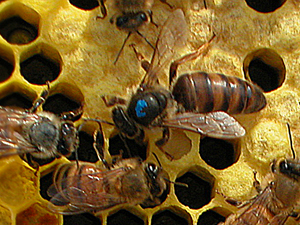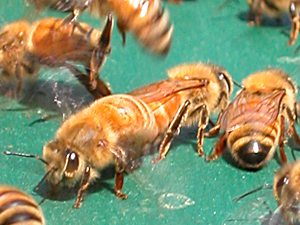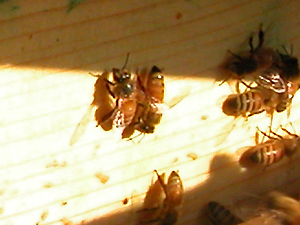But maybe I have something to show you, even now when there is not a (living) antenna to be seen. A few days ago MaryEllen shared with me a bit of wisdom that I can show you now, with a bit extra besides.
 The bee at top is Elizabeth, the Queen of the Wilde colony. That sporty blue mark came from the beekeeper who bred her. If you look at her, she resembles the bees' cousin the wasp more than her workers do. Notice that her broad shoulders have no fuzz, and that her butt is way long and tapered. I think she is pretty. This picture was taken in late May.
The bee at top is Elizabeth, the Queen of the Wilde colony. That sporty blue mark came from the beekeeper who bred her. If you look at her, she resembles the bees' cousin the wasp more than her workers do. Notice that her broad shoulders have no fuzz, and that her butt is way long and tapered. I think she is pretty. This picture was taken in late May. Now, here at the front left is a young worker bee, currently a house bee. After they emerge, bees spend about the first three weeks of their life doing tasks inside the hive. In this picture, it's a really hot day and the girls are fanning up a storm to try to cool the hot insides of the hive boxes. Take a look at her shoulders, where the wings attach. She is all golden and fuzzy! Most of the bees I see when opening the hives are like this: young and occupied with tasks like nursing young, drawing out honeycomb, and putting away honey stores. The girls were fanning so hard because it is still late May, and the BeeCool hive ventilators have not arrived. I think she looks like she is saying "Hurry up already with the AC!"
Now, here at the front left is a young worker bee, currently a house bee. After they emerge, bees spend about the first three weeks of their life doing tasks inside the hive. In this picture, it's a really hot day and the girls are fanning up a storm to try to cool the hot insides of the hive boxes. Take a look at her shoulders, where the wings attach. She is all golden and fuzzy! Most of the bees I see when opening the hives are like this: young and occupied with tasks like nursing young, drawing out honeycomb, and putting away honey stores. The girls were fanning so hard because it is still late May, and the BeeCool hive ventilators have not arrived. I think she looks like she is saying "Hurry up already with the AC!" It's not easy to get a picture of an old bee: they tend to be out in the field during the day when I make my visits, and they try to die outside of the hive so no other bee has the extra work of pushing them out the front door when they pass. The bee furthest to the left has probably lived most of her life by now. Look at her shoulders: the fur has been worn off of her back, probably scraped away little by little by all of her trips in and out of the narrow hive entrance.
It's not easy to get a picture of an old bee: they tend to be out in the field during the day when I make my visits, and they try to die outside of the hive so no other bee has the extra work of pushing them out the front door when they pass. The bee furthest to the left has probably lived most of her life by now. Look at her shoulders: the fur has been worn off of her back, probably scraped away little by little by all of her trips in and out of the narrow hive entrance. Recently on one of the BeeSource bulletin boards, some expert beekeepers mentioned that the reason honeybees "wear out" after six weeks is that they lose the ability to make replacement parts once they are full grown. Adult bees eat no protein, just the nectar of plants and honey, after they take flight. The pollen they collect — a particularly pure vegetable protein — is just for the young. The Queen lives up to 5 years, maybe because she is made of more durable stuff and does not do the hard work of outside foraging.
Now they are all hunkered down in a big ball o'bees inside those boxes. I wonder if the work of keeping warm is harder or easier than the other tasks they set themselves. I look forward to seeing them again when the sun shines.
No comments:
Post a Comment